The Story Behind the Streetcar Referendum
Conservatives from outside Milwaukee hope to join forces with black city residents to oppose the streetcar.
The recently announced petition drive to force a referendum opposing city expenditures for a streetcar system seems straightforward on its face, but there’s far more to the story. In fact, this exercise in participatory democracy provides a smokescreen for another agenda, which is an attempted right-wing seduction of African-American voters for political reasons.
Central city residents could be a prime field for new recruits, since many African-American voters, although they traditionally vote Democratic, lean right on some issues, particularly social ones like abortion or same-sex marriage.
An opening to the minority community came via an unlikely source — the John Doe investigation of the campaign practices of Governor Scott Walker overseen by Milwaukee County District Attorney John Chisholm. As Urban Milwaukee has previously reported, conservative groups and Republicans angered at the investigation and largely from outside the city made common cause with black activists who were unhappy about Chisholm’s response to the handling of African American suspects in custody. Chisholm initially refused to press charges against the police in whose custody Derek Williams died (the D.A later appointed a special prosecutor who decided there wasn’t sufficient evidence to go to court). Chisholm also declined to press charges after the death of 16-year-old Corey Stingley, who had been grabbed and restrained by three white male customers after he stole some items from VJ’s Food Mart in West Allis, and died of died of positional asphyxia, or a lack of oxygen.
For months, this group of white conservatives and black city activists talked about launching a recall of Chisholm. The group for a time included Orville Seymer and Chris Kliesmet, longtime leaders of the Citizens for Responsible Government, the organization that got its start pushing for the recall of Milwaukee County Executive F. Thomas Ament after the pension scandal broke. The Chisholm recall was never launched, but the issue helped create some political connections that may help Ald. Joe Davis, who has announced his run against Mayor Tom Barrett in the 2016 mayoral election. Republicans and conservatives would like nothing better than to find an opponent who could drive a strong turnout of black voters for a candidate to oppose the liberal mayor. City Hall insiders have been predicting that Davis and South Side Ald. Bob Donovan will be both be looking to draw donations from Republicans looking to defeat or at least embarrass and weaken Barrett. And the streetcar is a perfect issue for Donovan and Davis to prove their conservative stripes.
For Donovan, that’s a natural. He has always been a tough-on-crime conservative who’s adamantly opposed to the streetcar. But for Davis, who is a huge fan of trains and once proposed a light rail plan that might have cost as much as $1 billion, his opposition to the streetcar is more difficult to explain. Not to mention that Davis is also a former steamfitter and retiree of Local 601 and it will be members of the pipe trade unions like 601 who will earn the millions of dollars in wages that will be spent relocating utilities for the streetcar line.
In late December, Davis was seen at Miss Katie’s Diner meeting with Seymer, Kliesmet and two other Republicans: consultant Gerard Randall, Jr. and PR man Craig Peterson. Kliesmet and Seymer have already announced the CRG group will be organizing the petition drive to force a referendum on the streetcar.
According to the state’s direct legislation statute, organizers have 60 days to accumulate petitions equal to 15 percent of the city’s vote in the most recent gubernatorial election. According to the CRG website, “That number is 30,800 signatures but the goal is 35,000 signatures given that some signatures may be disallowed for various technical reasons.”
The group hopes to have the signatures in hand before the scheduled January 21st Common Council vote on streetcar funding. One insider tells us that CRG has a huge group of people willing to circulate petitions. That may include some police and fire workers.
The “technical reasons” for disallowing petitions should prove to be interesting, and a potential contested point during petition review. You don’t even have to be a registered voter in the City of Milwaukee to sign the petition — you merely have to be a city resident who is eligible to vote, meaning you’re over 18 years of age, with voting privileges not suspended. These signatures and qualifications will be much harder to check than the usual review of nomination papers, which may only be signed by registered voters, and easily checked against a list.
Standards are even more relaxed for petition circulators: “Any person eligible to vote anywhere in the U.S. can circulate a petition for signature.” In short, it’s legal for non-city residents to circulate petitions, which allows CRG to recruit widely for volunteers.
CRG notes on its website that the referendum language was written by an attorney, without identifying the party involved.
Esenberg’s response: “I can tell you that we have provided certain advice to CRG. That advice is confidential and privileged so I can’t give you any of the details.”
While much of the organizing on the streetcar petition seems to be by non-city residents, the high-profile involvement of Davis and Donovan helps give it a Milwaukee face. If the drive succeeds, it at the very least delays the streetcar until a referendum is held. Meanwhile the petition drive helps identify voters who are likely opponents of the Barrett administration, providing a good base on which to build the candidacy of Davis or Donovan, depending on which candidate gets through the primary. It also provides an opportunity to foment opposition to the streetcar and Barrett in the black community, by arguing that this is really just a transit system for whites.
Streetcar opponents also hope to mount electoral challenges in 2016 to some Common Council members who support the project. One insider in the effort predicted there will be an African American opponent in 2016 running against Downtown Ald. Bob Bauman, whose district has a black majority. How all this plays out may depend on African American Common Council members, and whether they come out strongly in defense of the streetcar, or whether they buy the Davis argument that this project has no upside for non-whites.
Project Background
- Council Delays Streetcar Until January – Jeramey Jannene – December 16th, 2014
- Committee Takes No Action on Streetcar – Jeramey Jannene – December 10th, 2014
- Committee Approves Milwaukee Streetcar – Jeramey Jannene – December 9th, 2014
- RACM Approves Tax Funding for Streetcar – Michael Horne – December 8th, 2014
- How to Sell the Streetcar – Michael Horne – November 28th, 2014
- Next Stops for the Streetcar – Michael Horne – November 24th, 2014
- Barrett Moving Forward with Streetcar – Jeramey Jannene – November 18th, 2014
- Who Will Be Streetcar Operator – Michael Horne – May 8th, 2014
- A Streetcar Named Cooperation? – Dave Reid – April 27th, 2014
- How a Streetcar Spurs Development – Angie Schmitt – November 3rd, 2013
- Streetcar Social – Michael Horne – September 12th, 2013
- Mayor Says Streetcar is a “Trojan Horse” – Michael Horne – April 17th, 2013
- Whoops, We Changed Our Mind – Dave Reid – September 27th, 2012
- Battle of the Bobs: Donovan vs Bauman Streetcar Press Conference – Jeramey Jannene – May 18th, 2012
- Important Hoan Bridge and Milwaukee Streetcar Meetings This Week – Dave Reid – November 14th, 2011
- Milwaukee Streetcar Passes Common Council – Jeramey Jannene – July 26th, 2011
- Keep the Milwaukee Streetcar Moving Forward – Jeramey Jannene – July 8th, 2011
- Milwaukee Streetcar at Apex – Jeramey Jannene – June 16th, 2011
- Milwaukee Streetcar Takes Key Step Forward – Jeramey Jannene – May 6th, 2010
- Milwaukee Streetcar Meeting This Thursday – Jeramey Jannene – October 5th, 2009
- Milwaukee Streetcar Routes Unveiled by Mayor Barrett – Jeramey Jannene – September 21st, 2009
- Milwaukee Streetcar Round-Up – Jeramey Jannene – April 19th, 2009
- Vote for your Favorite Milwaukee Streetcar Route – Jeramey Jannene – March 25th, 2009
- Design Your Own Streetcar Route – Jeramey Jannene – March 23rd, 2009
- Streetcars Coming to Milwaukee – Dave Reid – March 14th, 2009
Project Renderings and Maps
More about the Milwaukee Streetcar
For more project details, including the project timeline, financing, route and possible extensions, see our extensive past coverage.
- Streetcar Begins Daily Service To The Couture, BRT Will Soon Follow - Jeramey Jannene - Apr 11th, 2024
- Milwaukee’s Three Streetcar Extensions Need Mayoral Direction - Jeramey Jannene - Nov 8th, 2023
- Transportation: Streetcar Extension Opens Sunday - Jeramey Jannene - Oct 28th, 2023
- Ride Along On Streetcar Extension Before It Opens - Jeramey Jannene - Oct 11th, 2023
- Lakefront Streetcar Extension Opens October 29 - Jeramey Jannene - Aug 22nd, 2023
- Streetcar Ridership Has Climbed For 27 Straight Months Year-Over-Year - Jeramey Jannene - Jul 28th, 2023
- Transportation: Harley-Davidson Is New Streetcar Sponsor - Jeramey Jannene - Jul 7th, 2023
- Committee Backs 4 Streetcar Extensions - Jeramey Jannene - Jun 28th, 2023
- Garbage Truck Crashes Into Streetcar - Jeramey Jannene - Mar 27th, 2023
- Eyes on Milwaukee: City Has $16 Million Plan For Downtown Plaza - Jeramey Jannene - Mar 10th, 2023
Read more about Milwaukee Streetcar here
Political Contributions Tracker
Displaying political contributions between people mentioned in this story. Learn more.
- September 8, 2018 - Tom Barrett received $200 from John Chisholm
- March 14, 2016 - Tom Barrett received $50 from John Chisholm
- January 29, 2015 - Joe Davis, Sr. received $1,000 from Craig Peterson
- January 27, 2015 - Joe Davis, Sr. received $500 from Gerard Randall
Murphy's Law
-
Is Legislature Biased Against Working Class?
 Apr 4th, 2024 by Bruce Murphy
Apr 4th, 2024 by Bruce Murphy
-
Associated Press Will Decline in Wisconsin
 Mar 27th, 2024 by Bruce Murphy
Mar 27th, 2024 by Bruce Murphy
-
City Attorney Race Is Vitally Important
 Mar 25th, 2024 by Bruce Murphy
Mar 25th, 2024 by Bruce Murphy
Plenty of Horne
-
Notables Attend City Birthday Party
 Jan 27th, 2024 by Michael Horne
Jan 27th, 2024 by Michael Horne
-
Will There Be a City Attorney Race?
 Nov 21st, 2023 by Michael Horne
Nov 21st, 2023 by Michael Horne
-
Sprecher Brewery Aims To Be National Soft Drink Leader
 Oct 20th, 2023 by Michael Horne
Oct 20th, 2023 by Michael Horne

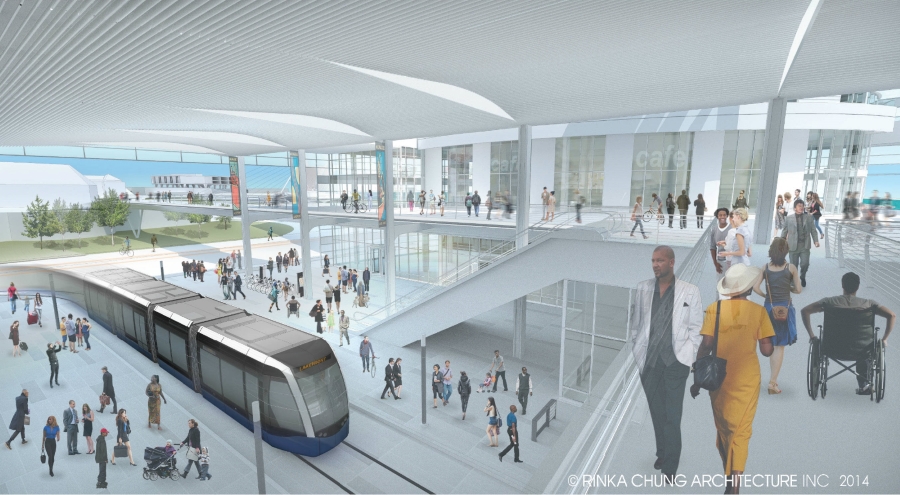
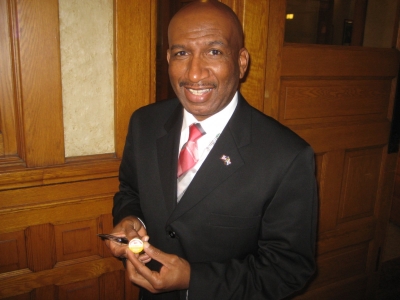
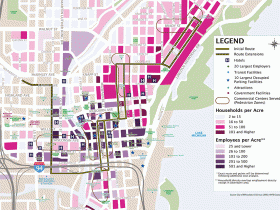
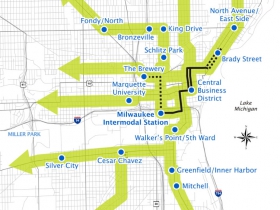
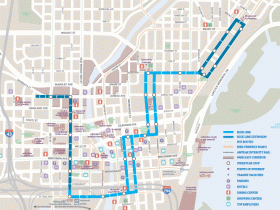
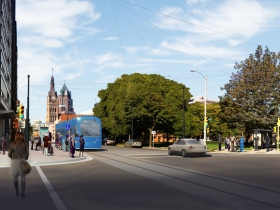
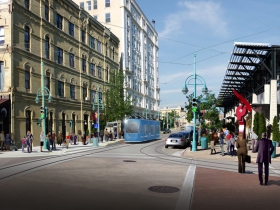
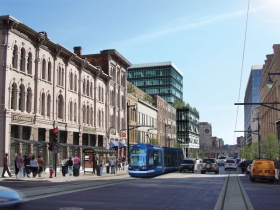



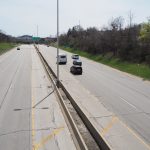











I’m not a huge fan of the streetcar mainly because of the chosen route but this is so sad that Davis is taking this stand considering that the predominatly black near northside would benefit the soonest from the line extensions.
I really look forward to the King Drive and FDL extensions.
I support the street car concept because the smartest people that in city support it but what is the deal with the routes?
PS: if Gerard Randall is on their side then that’s good news for our side!
Another case of playing the race card.
The street car system is a weird bait and switch in the public funds community. Successful future communities are going to have cheap and safe mass transportation, (and those that don’t, aren’t going to be successful) but this little fun-ride of a street car doesn’t make the grade. Every dime they want to dump into this should be dumped into more buses and a higher mass trans frequency schedule (something that could really make the bus schedule world class for a fraction of the money of this thing). I can’t figure out if people are promoting this because they think it will be easier to add on to these after they’re already built, or if they really think this putzy little ride is going to make them a “world class city”. Milwaukee’s neediness to see itself as a large city “playa”, has always been problematic in this community, and how we got stuck being held-up for a baseball stadium (to enhance a private business owner) where it is and not downtown, and how we’ll get held-up again over a basket-ball arena that the paint isn’t even dry on from before (again, tax money to enhance a private business owner). People here better wake up. The “intelligencia” of this community (and I use the term loosely), really think that this stuff ads to the “quality of life” issues, but it’s money poorly spent. Any mass trans consultant will tell you that a system that runs on rails, on the street, is the worst possible solution. Stuck in rush hour traffic and unable to move out of the lane. More corporations, higher paid jobs, lower rents, and property taxes, and the rest will follow.
Still curious how Davis explains to his base how he’s partnering with Orv Seymer, a nefarious slum lord who preys on inner city residents. Look up his DNS record. That man is soulless.
Andy, how do you dump every penny meant for the street car into busses when the funds are specifically for the streetcar and cannot be used for anything but rail transit? If we don’t use them the feds will give them back to another community. It would take an act of Congress to change that.
Don’t forget Milwaukee’s most famous burger slinger, David Sobelman. I understand that he (and possibly his staff) is behind the STOP the Streetcar facebook page which seems to be VERY in tune with the petition and misinformation campaign.
What I would like to know is if these people feel so strongly about “democracy” and “having their voices heard” on “large spending issues”, is whether I, as a Milwaukee citizen and tax payer can have a say on the cushy compensation and benefits we heap upon police and firefighters that suck up over half of the city’s 1.5 BILLION dollar budget.
In case anyone’s wondering, you can find said petition at Sobelman’s, Sherman Perk Coffee Shop, the Packing House and The Plainfield Pub. If anyone else knows of other places, I’d love to know so I can put them on my lists of places to NEVER patronize ever again.
Also, if anyone missed it, I thought this piece summed up my thoughts nicely…
http://onmilwaukee.com/buzz/articles/trollyopponents.html
The Streetcar SHOULD help Milwaukee, especially downtown to attract businesses and young professionals. A rising tide, does lift all boats. Killing the project WILL hurt Milwaukee.
Additionally, this first phase will cost us very little. Half the funds are dedicated to the project, and half are dedicated from new or expanded TID districts. We’re not taking away taxes being paid today from anything. The most we could potentially pay towards operations is estimated to be about 2 million dollars (I’m not a fan of using parking revenue to make up for expenses not paid for with fares or grants). For some perspective, 2 million in a 1.5 billion dollar budget is 0.1%. For us, that’d be an extra $2 a year! Opponents need to get a clue.
Right wing seduction of black people for political reasons. Run, quick the right wing is coming. Bruce, yu are riot. LUV to read these soliliquies that are in the clouds. No, the Conservatives want to help get the inner city folks out of the bondage delivered to them by the Liberal White Racists.
“…the bondage delivered to them by the Liberal White Racists.”
You sure about that or was it your relatives who took off at the first opportunity they could get to move to the burbs where they didn’t have about people who didn’t look like them taking the jobs with them and leaving behind a grossly segregated city?
I have lived in the city, owned property in the city and worked in inner city pharmacies for 50 years. Know the city and the people well. Had to take my faily out of the city when the Reynolds/Barbees wanted to bus my little girls all over Milwaukee to sub par educations. The unions and the Left control the schools in Milwaukee and they show it.
Well, at least your response led to this piece…
http://www.wisbar.org/newspublications/wisconsinlawyer/pages/article.aspx?Volume=77&Issue=4&ArticleID=740
Didn’t Craig Peterson do an independent expenditure ad attacking David Clarke’s opponent, with a message that blacks shouldn’t vote for him because he was a Milwaukee cop?
What are the benefits of a streetcar versus a bus? What can a streetcar do that a bus cannot? Never heard that addressed.
Yep – “Follow the Money”
You are incorrect that there is a difference between circulating nomination papers for candidates and for this referendum. The rules are exactly the same:
1. The signer has to be eligible and does not have to be registered.
2. A circulator does not have to be a resident of the city.
You should just delete that entire paragraph.
@Gary: How can you possibly say you’ve never heard the benefit of a streetcar over bus addressed? It seriously comes up in almost every one of these threads where some person (usually without any urban planning expertise or any substantive experience outside of Milwaukee’s insularity) raises the same question. It’s frustrating because people in Milwaukee actually act as though this is some new-fangled kooky idea that has never been used anywhere else and about which there is no data when the opposite is true.
First, there is an extremely well-documented phenomenon called rail preference. Locals (residents and commuters) and tourists alike find rail easier to use and more predictable and “nicer” than buses. Streetcars and other “fixed” transit almost always attract riders at levels that buses do not, and more important, they also attract choice riders–people who are not dependent on transit but who *choose* to use it. Younger college-educated people are a key portion of that, but they are not the only demographic. Older professionals are another target. (Think about places like Seattle or Portland or Chicago where a much wider range of people, not just the poor, ride transit, especially rail.)
Second, rail is fairly permanent. None of the modern light rail or streetcar systems in the US that have been added in recent decades have been torn up. Once a route is laid and stops are built, they’re going to be there for a long, long time. This attracts investment, much of which might not occur otherwise. Businesses want to be near fixed stops (even if they hate it during construction). It’s just an aspect of “location, location, location.” That doesn’t happen with plain old bus routes.
If you have doubts about this, visit the Twin Cities, where the Green Line (their second light rail line) opened this past year. While that is more expansive in scope than a streetcar, remember this: opponents said the same thing about buses….we just need more buses, why a train? Well, look at the HUGE ridership the Green Line gets relative to what came before it, surpassing expectations dramatically. Many are people who didn’t take the bus and wouldn’t take a slightly beefed up version of the bus either, but they like the train because they have positive associations with rail transit. They think of the “L” in Chicago, the subway in NYC, the “T” in Boston. And beyond that, look at the development. Just about every stop has new condos, new mixed use development, and new residents/businesses clamoring to move in. And all of this *despite* the fact that the train isn’t even that much faster than a bus. It’s just their idea of what a modern city has.
The starter streetcar system for Milwaukee makes sense. It’s in the densest part of the city where a huge number of people work and live, and the majority of the funding is not only secure but also not able to be reassigned anyway. And the expansion is uite easy to envision.
(Yes, the city needs to improve its bus routes as well, but that is an additional fight–not an either/or.)
Thanks Paul M.
Also, I would like to point out that it literally took me all of 6 seconds to find this on the Milwaukee Streetcar website:
“Can’t a bus do the same thing with more flexibility and cheaper?
Buses provide critical transportation service to thousands of people who need it to access jobs, education, entertainment, shopping, health care and more. But bus routes can be changed, and this is a disadvantage for economic development compared to fixed transit, such as streetcars. Streetcars offer permanence, which better guarantees to developers and the marketplace that the system will not move tomorrow. Therefore, cities across the country are seeing robust economic development and investment along streetcar lines. And, while streetcar systems do require an additional initial capital investment, operating a streetcar system is often less expensive per trip or passenger mile than traditional buses. This is true for many reasons, including that streetcars have a higher capacity than a bus and can move more people more efficiently with fewer vehicles, and because streetcar vehicles last many decades longer than buses, which are typically replaced about every 15 years.”
So it has been addressed.
Fix the buses first, now we have two systems that are inadequate.
Having been to Seattle and Portland recently the one thing that struck me was how many busses they have running. I naively expected everyone to be moving around via streetcar, Seattle even had a nice program where the bus was free during peak hours. The bus ran with such frequency in both places that you never had to wait more than a few minutes to get one and it made travel very convenient.
I get that cool millennials might prefer rail, but really I would be focusing on upgrading the buses (you can make a pretty nice bus) and increasing the volume of them. Let’s see if people really want mass transit because I’m not sure they do.
For right or wrong Milwaukee is a very easy city to get around in by car and most people prefer to travel that way.
The buses are steadily improving. They have modernized by using part of the same fund that is now dedicated to the Milwaukee Streetcar. I refer conservatives to this piece:
http://onmilwaukee.com/living/articles/mctsnewchangedroutes.html
In which the writer summarizes the many changes we have seen in the past 3 years, after the transit fund was divided to City/ to County over 3 years ago. It’s good to keep history in mind.
It is also good to keep economics in mind. The streetcar will offer something that rubber-wheeled buses cannot do: a fun, reliable, low cost, low expense ride.
And it will supplement the bus. Should it happen that the streetcar duplicates a bus downtown, the solution is simple. Make an adjustment in the downtown route, and a corresponding adjustment in one of our many neighborhood routes so that the bus system continues to serve the County at the most economical level it can. What the bus cannot do, command the investment attention of downtown spenders, the street can. The rubber tire is good but not the last word in transportation.
Obviously there has been a reasonable amount of opposition to this project, and this should have gone to a referendum long ago, if not to at least to avoid the standoff that is now occurring. If that referendum outcome indicating strong support were established, Barrett doubling down on the cost of the project would not be so hard for everyone to swallow. If the people of the city overwhelmingly want this as streetcar supporters claim, then what do they have to lose by being transparent and going to referendum?
It’s not like you can only have either/or right? I mean NYC has its subway system and buses. Same with Chicago. I used to take a bus to an El stop when we lived there. It was very easy and convenient. I get that the streetcar system is a risk, but I have yet to come across a really good reason as to why it’s a risk Milwaukee shouldn’t take.
there are those of us that want to see Milwaukee become a first class city again sntad of the worst ranking that we get in crime, school govt. etc You start with the neighborhoods and build up. if the neighborhoods are bad the rest will go bad, look at Detroit and RenCen.
Milwaukees problems are: crime, MPS, heroin, abandoned houses, corruption, incompetence, poverty, unemployment and human trafficking. That is where we should spend money, plus take this money for this dufus idea and put together
a good bus system.
How would you implement a good bus system? What does that look like? And why can’t a good bus system exist right alongside the streetcar? Plenty of cities nationwide have a bus system as well as a subway/light rail/train system.
they can, but we do not have unlimited money. Teh TIFs will drain money from the police force.
Rather than spend a billion or more dollars on unnecessarily expanding roadways, some of that money could go towards other methods of transportation.
Both of you are just grabbing money from wherever you like to make your case. That’s not how it works. The streetcar money doesn’t exist for more buses. The best case you can make is for the operating subsidy starting in about 3 years from when the streetcar would begin operation. That’s all the money you can swipe to support your buses, and even then you’ll have to deal with city vs. county issues. By the same token, you aren’t going to get the state to stop working on their freeway infrastructure to fund your local buses. The case can certainly be made that fiscal conservatives would look for less expensive ways to repair freeways and meet demand, but there’s no scenario where any of that state money would just be handed to Milwaukee County to get their bus system up to speed.
I understand how it works Kyle, and even if it’s not realistic to expect the state to shift any money from roadway expansion to another form of transportation, that doesn’t mean I’m going to stop believing that is the smart, right thing to do.
Peole in wisconsin travel by car, bus, not train or plane, in state. t/ehy want good roads so that we lso can run our commeerce. Cannot do that on a streetcar.
If Barrett had any clout he, would ask obama to let him fix the bus system with that money, it would do that for decades.
People in Wisconsin travel via Amtrak all the time. My wife is one of them, for work in Chicago. Amtrak is a train WCD.
I said in state, you cannot get to ?Crandon via Amtrak.
Do any of you realize that the TIF districts will take lots of money from the schools and police? For this really dumb idea? History will show that this is nuts.
WCD,
There are already 64 TIF Districts in the City of Milwaukee. Where was the outrage at the Beerline B, Brewery or Century City TIF creation? As you well know, the money that’s there for police and schools today will continue to hold steady from these areas throughout the life of the TID. Additionally, as the City grows and gets more popular deals like the Gardner Denver deal will get done and build in more money to keep extending the streetcar.
Stop it with the bus. See the Paul M. post above. The bus has an image problem. The exact reason you tout the bus as being superior (flexibility) is the exact reason rail creates development (a sense of permanence).
The question many people believe they are asking for the first time: why not the bus; with rubber tires it can go anywhere; flexibility is the ideal. Overlooked is what steel wheels can do that rubber wheels cannot.
One, steel wheels and rail draw into the vehicle people who would not be caught “dead” on a bus, an attitude that baffles regular bus riders.
Two, steel wheels draw the attention of investors. Who wants to invest in a 30 to 50 year developed space that is served by a “flexible” (fickle) bus route. And so we get lots of mini malls with plenty of wasted space to make sure every car that arrives gets a parking place – lots of empty space in those mall lots between the shopping hours.
Parking lots are the cheapest investments in a city with poor transit. Assessments in Milwaukee on the parking lot are low because the only “improvement” (also known as “building”) on the land is asphalt and maybe a shack. The land actually has more value than what our Assessor claims. It’s only a matter of time that the market discovers this. What the streetcar brings to this discussion is proof – that land may be more valuable than what is built upon it.
@Wisconsin Conservative Digest “If Barrett had any clout he, would ask obama to let him fix the bus system with that money, it would do that for decades.”
Just like the governor was able to fix the roads with the high speed rail money, as he said he would do, right? How’d that work out again?
WCD (post 32), your assertion that the $54.9 million in federal streetcar money, if used to “fix the bus system … would do that for decades,” is ridiculous.
Even if Congress passed a law allowing the money to be used for MCTS operations (Obama doesn’t have the authority to make this change on his own), the money would be all used up within a year.
To calculate this, I assumed a modest goal—bringing MCTS service up to 2002 levels (Scott Walker’s first year as Milwaukee County Executive).
In 2002, the MCTS fleet had 501 buses; in 2013, there were only 398 buses. New transit buses cost about $300,000–$400,000 each, and at $350,000, buying 103 new buses comes to $36 million.
More than half the money is gone (only $18.9 million remains), and we still have to pay to operate the new buses.
In 2002, MCTS buses operated 18.8 million miles; in 2013, 15.3 million miles. To restore that 3.5 million miles at $8.52 per mile (MCTS’ actual 2013 operating cost) would cost $29.8 million/year.
Assuming new fare money covers 31.2% of this added cost (31.2% is the actual 2013 MCTS farebox recovery ratio), you have an annual loss of over $20.5 million.
So adding enough bus service to bring us back to 2002 levels requires an additional $20.5 million operating subsidy, yet the total remaining money is only $18.9 million—not even enough for one year.
If we used the $54.9 million of federal streetcar money to restore MCTS to 2002 service levels, that money would be gone in under 12 months.
One addition to my previous post (#38):
All my data came from the National Transit Database, compiled by the US Department of Transportation.
The 2002 data is on page 27 of:
http://www.ntdprogram.gov/ntdprogram/pubs/profiles/2002/2002-Top-Complete.pdf
The 2013 data is on the 31st page (marked as “page 28”) of:
http://www.ntdprogram.gov/ntdprogram/pubs/top_profiles/2013/Transit%20Profiles%20Top%2050%20Agencies.pdf
Bill Sell (post 37):
I’d like to mention one other difference between buses and streetcars: sidewalk cafés don’t do well on major diesel bus routes. (I think that’s why Wisconsin Avenue has none.)
Diesel buses are noisy and their exhaust stinks. Streetcars are almost silent and have no exhaust fumes at all.
Yes I noticed in paris and prague that the sidewalk cafes were deserted. Dumb statement.
This TIF district is much different. usually the TIF is for the project in hand and does not take old money. This TIF will grab up old money that is being used for cops and MPS> How will that be replaced?
The idea that a little street car line that a new urban code writer making 250% of the average local income is going to want to ride for a few blocks from his or her apartment/condo at 250% of the local average to his or her job (which is probably going to be in Brookfield anyway), and all this is going to drive the “neo-creatives” to Milwaukee is ridiculous. Portland has buses, light rail, heavy rail, and controlled density (been there, worked there, loved it). You can’t steal one tube of Portland’s lipstick and put it on this pig, and say we’re a world class city. And that, in reality, is the problem with all of this. Those mass trans systems exist in Portland because Portland is Portland and they don’t exist here because Milwaukee is Milwaukee. Stealing one aspect of another city, like the Milwaukee Market, where you were so bold-faced you actually stole the type style right off the building in Seattle, doesn’t make this a world class city. The mentality of the city fathers and mothers and the will of the people make those cities who they are.
Backwards thinking people of German descent that want to take 20 years to think about something before they pull the trigger, then do the cheapest and worst permutation of that project, isn’t going to cut it. Voters that used to be “economic Democrats” when they had union jobs and it suited them to be so, and who now that they are retired are “neo-cons” and want to let the poor in the city suffer, are also not going to be voting in the cities best interests either.
Quit trying to vote in expensive “decorations” for a city that won’t change it’s stripes, and hoping that it’ll drive people to bring their money here. I just read a breakdown of “future cities” based on economics and policies. Indianapolis was 26th, Milwaukee was 127th! Milwaukee’s being supported by retired union pensioners and city and utility employees, everyone else doesn’t add up to any economic force at all…
WCD (post 40), the sidewalk cafés in Milwaukee along the streetcar route (on St. Paul, east of the River) are not deserted (in warmer weather). If you attempted to run a streetcar-equivalent bus line, you might well kill those cafés.
Sidewalk cafés add more to the economy than just some additional restaurant seats. They make sidewalks more inviting for pedestrians and improve real estate values throughout the whole neighborhood.
In Paris and Prague, Amsterdam, London there are sidewalk cafes all over place and there are buses everywhere. You are making something from nothing but sidewalk cafes are not a reason to spend 200 million when the schools are non functional.
Andy Umbo (post 42), Portland’s heavy rail has nothing to do with the success of Portland’s streetcar. Portland’s heavy rail line (“Westside Express Service”) opened 8 years after Portland’s streetcar (long after the streetcar was already proven a success).
About those “deserted” sidewalk cafes. WCD needs to get out of his house. And maybe visit Paris (or Milwaukee). http://s3.amazonaws.com/estock/fspid9/23/76/00/9/paris-cafes-2376009-o.jpg
Andy Umbo has given up. OK. Andy has given up. Next?
Bill does not read very well about sidewalk cafes. I said that in Prague and Paris the sidewalk cafes were full despite the fact that there were buses going by all the time. Anyway we are not going to build a street car to get sidewalk cafes.
Ha Ha Bill Sell, I gave up on Milwaukee in the 80’s. But, I even remember the brain drain of the 70’s, when 60% of my college graduation class left Milwaukee because they couldn’t even get started in their careers here: no work. Again, making Milwaukee something it isn’t by adopting the trappings of successful growing cities won’t work here no matter what. Milwaukee would have had a better chance if they had made the downtown look like “Old Heidleburg” and floated a big helium bratwurst over the art center all summer!
@Andy — Show me a city that has been improved by benighted negativity and small thinking such as yours (“it won’t work here no matter what”). It never ceases to amaze me that so many people in Milwaukee insist on its inferiority.
Over the years I have heard an obnoxious amount of this thinking. It’s like a meme that people don’t even unpack or question. It’s so strange, it’s almost masochistic.
Have you noticed that Milwaukee’s population has not only reversed its decline but actually begun to increase? There are people who leave here, sure, but there are also lots of people who move here. Have you ever considered what attracts the ones who come?
@ Tom D (Post 45)
Portland’s light rail system and urban growth boundary came long before the streetcar, and before they built the light rail they worked to reorganize and improve the bus system to encourage ridership. The streetcar works in Portland because it builds off the rest of the transit system, and because the whole Portland region was growing before the system was built. If we want to have Portland’s success it might be wise to look at the whole story there and invest in better zoning and regional transit connections (light rail, better bus service, etc) first…
@Paul M (Post 50)
Andy’s comments may have been overly negative but he has a very good point. Milwaukee’s economy sucks, our population is (at best) stabilizing in its decline, and we have apartheid-like conditions that make the quality of life for many black folks here (who Urban Milwaukee readers and civic boosters seem to forget make up 40% of the population) on par with many developing countries. Continuing to focus the vast majority of our public infrastructure spending on relatively well off white yuppies, underemployed college grads, and retirees while pretending like the majority of the city doesn’t exist isn’t going to improve Milwaukee. Talking about our problems and changing the way we develop and think about ourselves as a city will. South Africa didn’t change and improve by making life even nicer for whites no matter how many times they tried.
Streetcar in Old Heidelberg.
http://www.tripadvisor.co.nz/LocationPhotoDirectLink-g187286-i23888884-Heidelberg_Baden_Wurttemberg.html
Sam: you make good points, but these choices are not “either or” A full accounting of the unemployment in our city will require moves on several fronts.
Public transportation is one; streetcars will boost bus ridership, so that’s a plus for a bus system that is demeaned in so many public forums, usually demeaned by folks who continue to insist on getting a parking place.
Encouraging young people to stay; I know many that want to stay and make the city more oriented to the jobs that young people are trained to do.
Incarceration: our criminal system is devoted to locking up Blacks, and letting Whites off the hook.
A streetcar will not directly impact these problems, but it will boost access to jobs, along with offering a lower fare than the bus. These are not trivial contributions to the well being of people on the edge of poverty.
What Portland has that is forbidden in Wisconsin is regional transit. This is a mandate from the Capitol and required the municipalities to work together to make transportation a regional challenge. Oregon wiped away the route limits that “village thinking” enforced. Milwaukee’s straight jacket was made in Madison; our citizens had the good sense to vote in favor of local control of transit, with local funding.
@Bill Sell
How will a streetcar that goes within a block or two of all of the same places that the bus goes (just slower and not as late at night or early in the morning) boost access to jobs? Rail does not automatically equal improved job access no matter what.
And if the only concrete way you mention that a streetcar will benefit bus riders is by offering lower fares than MCTS, how will it increase bus ridership? Wouldn’t that have the effect of taking away riders from MCTS? Also, one of the main arguments for the streetcar is that it will attract riders that would never take the bus. If that’s the case, how will attracting these riders to the streetcar increase bus ridership?
When the city regularly uses the argument that it just can’t afford to invest in infrastructure and city services in the central city and then uses city tax money to build and cover the operating costs of a piece of infrastructure that is designed to help the city further centralize wealth in certain areas, it really is an “either-or” choice.
Everyone in Milwaukee, please sign the petitions to force the referendum on the street car,for CRG. Go to Facebook: Wisconsin Conservative Digest to get one.
Sam, Bill, etc. I was one of the ones that was “convinced to stay”, and I watched my own economic stability retreat, while even those among my college class that weren’t the “brightest tools in the shed”, moved on to better lives in other cities on the coasts. Wisconsin is now the last resort for businesses before they take their manufacturing to China or their computer work to India, and the salaries and advancement reflect that. Working for corporations that give no cost of living increase, while year end raises for the best performers might be somewhere between a .5 and 1.0 % increase is not going to cut it (not to mention some of the highest property taxes in the country). You wake up one morning, twenty years later, and realize you have no savings, are losing your job in your mid-fifties, and your company was bought by someone outside of the Milwaukee market, with no intention of spending their profits here. You would do any college graduate a huge disservice by trying to convince them to stay. Starting a business? Forget it, I’ve owned one, and compared to me doing business in other markets, it’s a “Germanic” nachtmare! Problem with this discussion, is most of the discussees don’t really understand how “bad” and different it is here…
@Sam (post 51),
It’s true that Portland’s light rail was in place before the streetcar and that the streetcar connects with the light rail, so part of Portland’s streetcar success is due to its light rail.
On the other hand, Milwaukee has more Amtrak service than Portland and Milwaukee’s streetcar connects directly to Amtrak (whereas neither streetcar nor light rail reached Portland’s Amtrak station until a year or two ago).
You also cite Portland’s urban growth boundary (“UGB”)—an arbitrary line, created by legislation, beyond which urban development is prohibited—as being a unique factor in the success of Portland’s streetcar.
While I’m not sure how much Portland’s UGB affects its streetcar, Milwaukee has its own UGB—Lake Michigan—which prohibits development east of town, thereby concentrating it in a smaller area. The Lower East Side’s many high-rises are a direct result of that boundary, and they will play a role in the success of Milwaukee’s streetcar.
@Sam (post 56),
The streetcar will be faster than a bus. In downtown, MCTS buses only average about 6 mph because of the time they spend at red lights and at bus stops. (Look at how long it takes Route 12, for example, to travel from the lakefront to 12th Street!) While the streetcar will still wait at red lights, it will spend less time at stops and will average nearly 9 mph.
Buses require everybody to enter single-file through a single narrow door, paying fare in the process. If they pay with cash, the line waits while each person’s money is fed into the farebox. There is typically one large step that must be climbed, which slows down older people (and the line only moves as fast as its slowest members). People can’t enter the bus at all until the bus “kneels” (drops its front a few inches) and until people exit via the front door.
Streetcars have multiple entry doors. Cincinnati’s, for example, have 4—all of which can be used to enter or exit because fares are paid in advance at curbside parking meters. (Instead of getting a receipt showing you’ve paid for 2 hours of parking, yours will say you’ve paid for 2 hours of streetcar use.) Streetcars don’t “kneel”; there are no steps while boarding because the curb will be rebuilt to exactly match the height of the streetcar floor and because the streetcar—guided by its inflexible rails—always pulls right up to the curb.
Have you ever been on a bus that picks up somebody in a wheelchair? It takes an extra minute or two to board that passenger (and another minute or two to discharge them later). Those delays are eliminated (or, at least, greatly reduced) with a streetcar.
When a bus is ready to leave a bus stop, it must wait for a break in traffic before it can pull out of the parking lane. Streetcars will instead stop in the traffic lane (the curb will be extended out through the parking lane at stops) and won’t waste time merging back into traffic.
Most of these savings sound like very much (just 15 or 30 seconds here and there), but when you stop every 2 blocks and only have about 14 minutes to complete a 2.1-mile trip, those savings add up.
Correction to last paragraph of Post 60:
Most of these savings DON’T sound like very much…
One of the justifications for the streetcar is that, once you get past its one-time construction costs, it pays for itself through an expanded tax base.
Both Portland and Seattle (the only two US cities with at least 12 months of modern streetcar operation) have seen billions of new construction along their streetcar tracks. If Milwaukee’s streetcar can trigger just $205 million in net new private development, the increased property taxes would exceed the operating subsidy (forever).
To put this $205 million number in perspective, the new NML building is $450 million, and the new building at 833 E Michigan is $102 million.
this is Wisconsin, we think differently. let us take a look at kenosha. Show me the development there and also explain why more than half the people are opposed to adding on and are fighting it with a petition referendum?
@WCD (post 63)
Kenosha’s streetcar is in some ways more of a museum piece than a serious transportation system. It never runs before 10 am, making it unusable for commuting, and it doesn’t run at all on weekdays for months at a time. It also differs from Milwaukee’s (and Portland’s and Seattle’s) streetcar because it isn’t a “modern streetcar” with all the post-war European improvements that seem key to triggering development.
Even so, hundreds of new condos, 2 new museums, and a new marketplace were developed along the tracks after the streetcar went in. (Google “Kenosha Harborpark”)
Tom, what baloney, I have property right down there for 40 years. Those condos had nothing to do with the street car. The museums and market place have nothing to do with it, in fact the businesses, in downtown including the Walgreens where I worked on several occasions have left. Street car does not run any more often for the same reason that the Milwaukee street car will not run cause no one rides it. They want to expand it, as everyone thought they will want to do in Milwaukee ,but everyone is fighting it.The referendum will send it down. I predict that 5 years from now they will toss it out.
The idea is exactly the same as Milwaukee, but the apologists that want to line their pockets in Miwlaukee always give some lame excuses as to why it does not work. It does exaclty what the Milwaukee thing wants to do, and it is failure.
@Tom D (Post 60)
The Portland Streetcar’s initial route’s scheduled speed is 6.5mph. With Milwaukee’s streetcar running in mixed traffic and likely regularly subjected to things like double parked cars I’m not sure why you would expect it to be better. Things like off-board fare collection, in traffic stopping and all-door boarding aren’t exclusive to streetcars.
Andy, I am sorry to learn about your bad luck with your business efforts in this city. Mine is over 30 years old and it has succeeded in terms of the goals I set for it. No offense meant to you, but I have learned to be the oldest person in the room, and to learn from what is on the minds of young people. Those are the people whom I am listening to. I’ve seen adults “mature” (get self-centered and ornery, some few go bitter), and I don’t listen to that self-indulgence. I believe in our youth and am refreshed when I read their writing, or view their art, or listen to their music. They are the Milwaukee I am working for, not me, not anyone who can’t keep up with the minds of young people. Soon, it’s all up to them Truth be told, the Young are the only asset that the Old can trust.
Sam, re your parry:
“And if the only concrete way you mention that a streetcar will benefit bus riders is by offering lower fares than MCTS, how will it increase bus ridership?”
There is no “only” in the predicate of the streetcar.
Let me count the ways the streetcar will benefit bus riders. New streets covered, less walking in any weather, getting around downtown on errands, downtown residents leaving the car in the garage, taking a bicycle on board, quick run to the post office, simple commute to Amtrak, parking once, extending transit rides, inviting more bus service (such as Lincoln Memorial Drive which is flooded with cars on a warm weekend). Low fares will have little appeal for your wealthy riders, but those same riders will appreciate timeliness and the ability to get around the downtown efficiently. It will attract downtown minimum wage workers. More car pooling because your driver can drop you at a streetcar stop for a cheap final mile.
Sam, sorry, but I no longer live in Milwaukee, some one directed me to this conversation knowing how I feel about the city and how much I love rail commuting (having lived in DC for a number of years). I mention all of this not because I’m “bitter”, but because I have so much valuable experience both working in Milwaukee trying to get things done, and working in other urban areas on the coasts actually really getting things done! It’s why I have no hope for Milwaukee, the “young” minds that really would have gotten things done in every generation over the last 50 years were the ones that ended up getting frustrated and became part of the “brain drain”. They’re the ones that have advanced whatever cities they moved to over the years, while Milwaukee’s policies and business mentality has driven it downward (and the best and the brightest ‘out’). Understanding what to do for your own peace of mind and advancement is understand when “enough is enough”. The German mentality of Milwaukee is the thing that keeps people thinking their lack of success is of their own making, instead of realizing it’s their lousy environment. Many, many stories exist of people who strived heroically to make something of themselves and their place in the city, only to be relegated to near failure; then to be met with success when bringing their knowledge and experiences out of Milwaukee to places where it would be appreciated.
Again, as for the “trolley”, and as someone who loves the Metro system in DC and used it every day, any mass trans system that runs on the same streets as car traffic is non-viable. It DOES get caught in traffic jams when people block cross streets or get stuck while crossing over the tracks to turn. If the city wants to spend money making a “fun-time” trolley for it’s lower east side rich folks and to try and get tourists to come, hell, then say that (and you’d be wrong about the tourists), but don’t try to sell it as the first leg of a neo-mass-trans system.
Oops, sorry I meant the above to be addressed to Bill Sell
@Sam (post 66),
I got the 9mph speed from Milwaukee’s commitment to 10-minute headways using 3 vehicles and 15 minute headways with 2. (Its initial fleet is 4 vehicles reserving one vehicle as a “spare”.) Those numbers require that a round-trip (including end-of-line layovers) take 30 minutes, or 15 minutes each way. If there is a 1-minute layover at each end, you have 2.1 miles in 14 minutes or exactly 9 mph.
I cannot explain the difference between 9 mph and the 6.5 mph you cite in Portland. Perhaps Milwaukee plans to change traffic signals to give streetcars priority. Also, none of the streets used by the streetcar have heavy traffic.
I don’t see double-parked vehicles as a problem. People who double-park in bus lanes assuming the bus can just go around won’t do that on streetcar tracks. (Incidentally, when buses “just go around” a double-parked vehicle, they lose time—another reason why “flexible” buses are slower than “inflexible” streetcars.)
You are correct that off-board fare collection, in-traffic stopping, and all-door boarding aren’t exclusive to streetcars, but those time-saving features aren’t cheap—one reason Milwaukee’s streetcar is so expensive). Cleveland did just that with its recently-completed “Health Line” buses and ended up spending $200 million for 6.8 miles.
And buses that offer those features sometimes only offer “watered-down” versions. For example, “all-door boarding” on a bus usually means “2-door boarding”, but never the “4-door boarding” offered by Cincinnati’s streetcar.
walker has little clout with Obama and co.